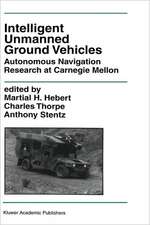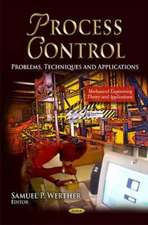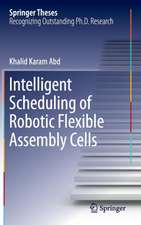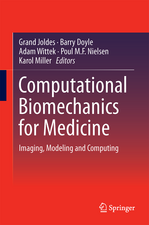Vision and Navigation: The Carnegie Mellon Navlab: The Springer International Series in Engineering and Computer Science, cartea 93
Editat de Charles E. Thorpeen Limba Engleză Hardback – 30 apr 1990
| Toate formatele și edițiile | Preț | Express |
|---|---|---|
| Paperback (1) | 1276.08 lei 43-57 zile | |
| Springer Us – 12 iul 2012 | 1276.08 lei 43-57 zile | |
| Hardback (1) | 1282.50 lei 43-57 zile | |
| Springer Us – 30 apr 1990 | 1282.50 lei 43-57 zile |
Din seria The Springer International Series in Engineering and Computer Science
- 24%
 Preț: 1041.97 lei
Preț: 1041.97 lei - 20%
 Preț: 643.50 lei
Preț: 643.50 lei - 18%
 Preț: 1225.62 lei
Preț: 1225.62 lei - 18%
 Preț: 965.02 lei
Preț: 965.02 lei - 20%
 Preț: 646.12 lei
Preț: 646.12 lei - 18%
 Preț: 948.79 lei
Preț: 948.79 lei - 20%
 Preț: 646.62 lei
Preț: 646.62 lei - 15%
 Preț: 637.46 lei
Preț: 637.46 lei - 20%
 Preț: 643.83 lei
Preț: 643.83 lei - 18%
 Preț: 949.23 lei
Preț: 949.23 lei - 20%
 Preț: 644.48 lei
Preț: 644.48 lei - 20%
 Preț: 994.92 lei
Preț: 994.92 lei - 20%
 Preț: 645.97 lei
Preț: 645.97 lei - 18%
 Preț: 946.87 lei
Preț: 946.87 lei - 20%
 Preț: 995.57 lei
Preț: 995.57 lei - 18%
 Preț: 956.99 lei
Preț: 956.99 lei - 20%
 Preț: 644.98 lei
Preț: 644.98 lei - 15%
 Preț: 649.54 lei
Preț: 649.54 lei - 18%
 Preț: 950.21 lei
Preț: 950.21 lei - 18%
 Preț: 1221.38 lei
Preț: 1221.38 lei - 18%
 Preț: 957.62 lei
Preț: 957.62 lei - 15%
 Preț: 643.99 lei
Preț: 643.99 lei - 18%
 Preț: 948.47 lei
Preț: 948.47 lei - 18%
 Preț: 947.35 lei
Preț: 947.35 lei - 20%
 Preț: 1284.65 lei
Preț: 1284.65 lei - 20%
 Preț: 1628.31 lei
Preț: 1628.31 lei - 20%
 Preț: 1285.78 lei
Preț: 1285.78 lei
Preț: 1282.50 lei
Preț vechi: 1603.13 lei
-20% Nou
Puncte Express: 1924
Preț estimativ în valută:
245.40€ • 256.91$ • 203.06£
245.40€ • 256.91$ • 203.06£
Carte tipărită la comandă
Livrare economică 07-21 aprilie
Preluare comenzi: 021 569.72.76
Specificații
ISBN-13: 9780792390688
ISBN-10: 0792390687
Pagini: 370
Ilustrații: XIV, 370 p.
Dimensiuni: 156 x 234 x 22 mm
Greutate: 0.72 kg
Ediția:1990
Editura: Springer Us
Colecția Springer
Seria The Springer International Series in Engineering and Computer Science
Locul publicării:New York, NY, United States
ISBN-10: 0792390687
Pagini: 370
Ilustrații: XIV, 370 p.
Dimensiuni: 156 x 234 x 22 mm
Greutate: 0.72 kg
Ediția:1990
Editura: Springer Us
Colecția Springer
Seria The Springer International Series in Engineering and Computer Science
Locul publicării:New York, NY, United States
Public țintă
ResearchCuprins
1. Introduction.- 1.1. Mobile Robots.- 1.2. Overview.- 1.3. Acknowledgments.- 2. Color Vision for Road Following.- 2.1. Introduction.- 2.2. SCARF.- 2.3. UNSCARF.- 2.4. Results and Conclusions.- 2.5. References.- 3. Explicit Models for Robot Road Following.- 3.1 Implicit Models Considered Harmful.- 3.2 Systems, Models, and Assumptions.- 3.3 FERMI.- 3.4 References.- 4. An Approach to Knowledge-Based Interpretation of Outdoor Natural Color Road Scenes.- 4.1. Abstract.- 4.2. Introduction.- 4.3. Related Work.- 4.4. Adjustable Explicit Scene Models and the Interpretation Cycle.- 4.5. System Overview.- 4.6. Results of the Road Scene Interpretation.- 4.7. The Road Scene Interpretation System in Detail.- 4.8. Future Work.- 4.9. Conclusion.- 4.10. Acknowledgement.- 4.11. References.- 5. Neural Network Based Autonomous Navigation.- 5.1. Introduction.- 5.2. Network Architecture.- 5.3. Training And Performance.- 5.4. Network Representation.- 5.5. Discussion And Extensions.- 5.6. Conclusion.- 5.7. References.- 6. Car Recognition for the CMU Navlab.- 6.1 Introduction.- 6.2 Related work.- 6.3 The LASSIE object recognition program.- 6.4 Results.- 6.5 Directions for future work.- 6.6 Summary.- 6.7 References.- 7. Building and Navigating Maps of Road Scenes Using Active Range and Reflectance Data.- 7.1. Introduction.- 7.2. Following roads using active reflectance images.- 7.3. Building maps from range and reflectance images.- 7.4. Map-based road following.- 7.5. Conclusion.- 7.6. References.- 8. 3-D Vision Techniques for Autonomous Vehicles.- 8.1. Introduction.- 8.2. Active range and reflectance sensing.- 8.3. Terrain representations.- 8.4. Combining multiple terrain maps.- 8.5. Combining range and intensity data.- 8.6. Conclusion.- 8.7. References.- 9. The CODGER System for Mobile RobotNavigation.- 9.1 Introduction.- 9.2 Overview of the CODGER System.- 9.3 Data Storage and Transfer.- 9.4 Geometric Representation and Reasoning.- 9.5 Conclusions.- 9.6 References.- 10. The Driving Pipeline: A Driving Control Scheme for Mobile Robots.- 10.1 Introduction.- 10.2 Processing Steps and Driving Unit.- 10.3 Continuous Motion, Adaptive Control, and the Driving Pipeline.- 10.4 The Driving Pipeline in Action: Experimental Results.- 10.5 Conclusion.- 10.6 References.- 11. Multi-Resolution Constraint Modeling for Mobile Robot Planning.- 11.1 Introduction.- 11.2 The Local Navigation Problem.- 11.3 Finding Trajectories.- 11.4 Experiments.- 11.5 Conclusions.- 11.6 Acknowledgements.- 11.7 References.- 12. Navlab: An Autonomous Navigation Testbed.- 12.1 Introduction.- 12.2 Controller.- 12.3 Vehicle Shell.- 12.4 Locomotion.- 12.5 Electrical System.- 12.6 Telemetry.- 12.7 Perceptive Sensing and Computing.- 12.8 Conclusion.- 13. Vehicle and Path Models for Autonomous Navigation.- 13.1 Introduction.- 13.2 Vehicle Representation.- 13.3 Path Representation.- 13.4 Path Tracking.- 13.5 Results.- 13.6 Conclusions.- 13.7 References.- 14. The Warp Machine on Navlab.- 14.1 Introduction.- 14.2 History of the Warp Machine on Navlab.- 14.3 FIDO.- 14.4 SCARF.- 14.5 ALVINN.- 14.6 Evaluation of the Warp Machine on Navlab.- 14.7 Conclusions.- 14.8 References.- 15. Outdoor Visual Navigation for Autonomous Robots.- 15.1 Introduction.- 15.2 Example Systems.- 15.3 Discussion and Conclusions.- 15.4 Acknowledgements.- 15.5 References.



















